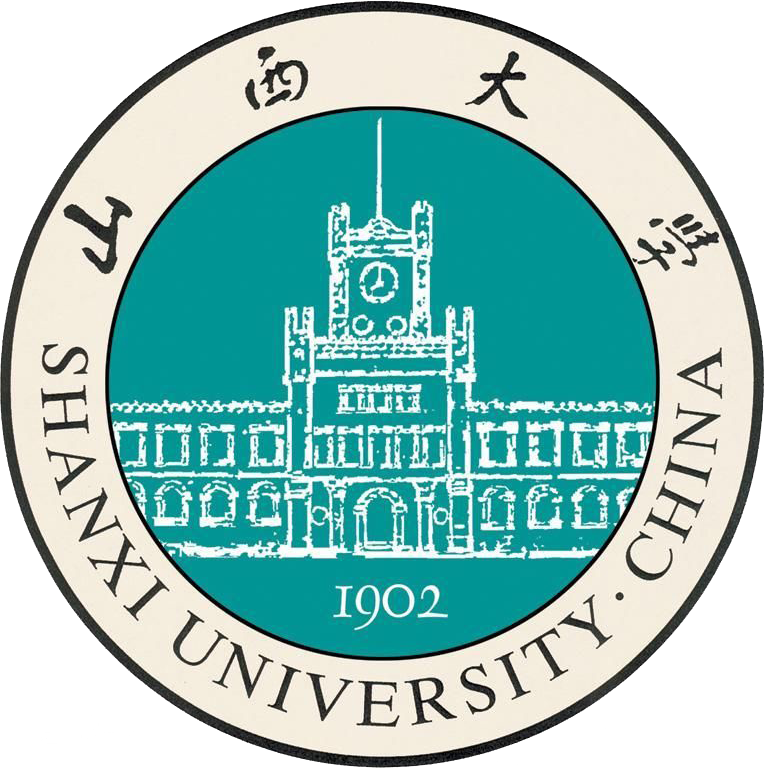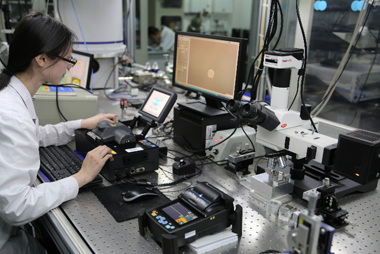
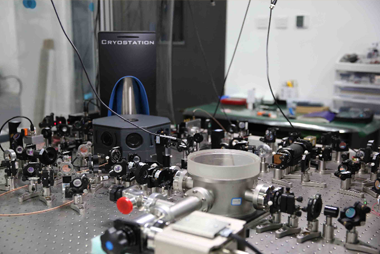

量子通信是量子物理与信息科学的交叉学科,在实现信息的无条件安全传送、量子信息的操控、传递等方面具有重要的应用。课题组主要开展量子通信方面的实验和理论研究,针对量子通信的新原理、新方法进行探索和研究,并由此发展量子通信的相关新技术,研制相关原理型器件和样机,推进量子通信的发展和实用化。近期的研究方向:连续变量量子保密通信;腔量子光力;光场量子态工程和操控。
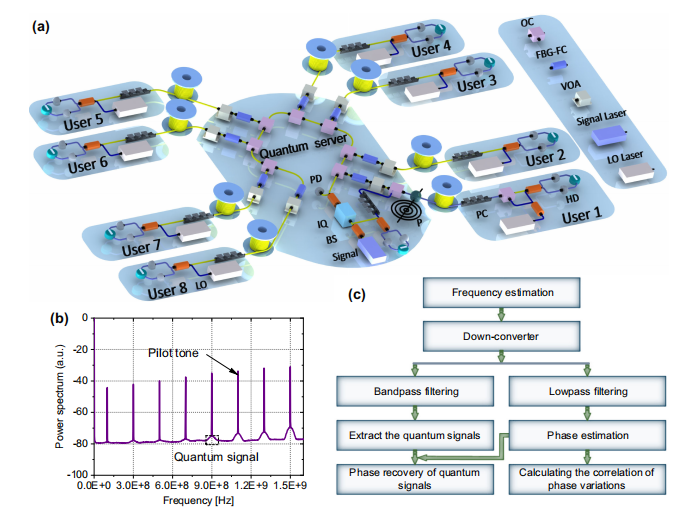
Integrated quantum communication network and vibration sensing in optical fibers
Authors:Shuaishuai Liu, Yan Tian, Yu Zhang, Zhenguo Lu, Xuyang Wang, and Yongmin Li
Communication and sensing technologies play crucial roles in various aspects of modern society. The seamless combination of communication and sensing systems has attracted significant interest in recent years. Without adding core devices, vibration-sensing functions can be integrated to build a quantum network with high efficiency and versatility. In this study, we propose and demonstrate a network architecture that integrates a downstream quantum access network (DQAN) and vibration sensing in optical fibers. By encoding the key information of eight users simultaneously on the sidemode quantum states of a single laser source and successively separating them using a specially designed narrow-bandwidth filter network, we achieved a secure and efficient DQAN with an average key rate of 1.94 × 104 bits per second over an 80 km single-mode fiber. Meanwhile, vibration locations with spatial resolutions of 131, 25, and 4 m at vibration frequencies of 100 Hz, 1 kHz, and 10 kHz, respectively, were implemented using the existing DQAN system infrastructure. The results indicate that the backward probe beam has a negligible effect on the DQAN system. Our integrated architecture provides a viable and cost-effective solution for building a quantum communication sensor network and paves the way for the functionality expansion of quantum communication networks.
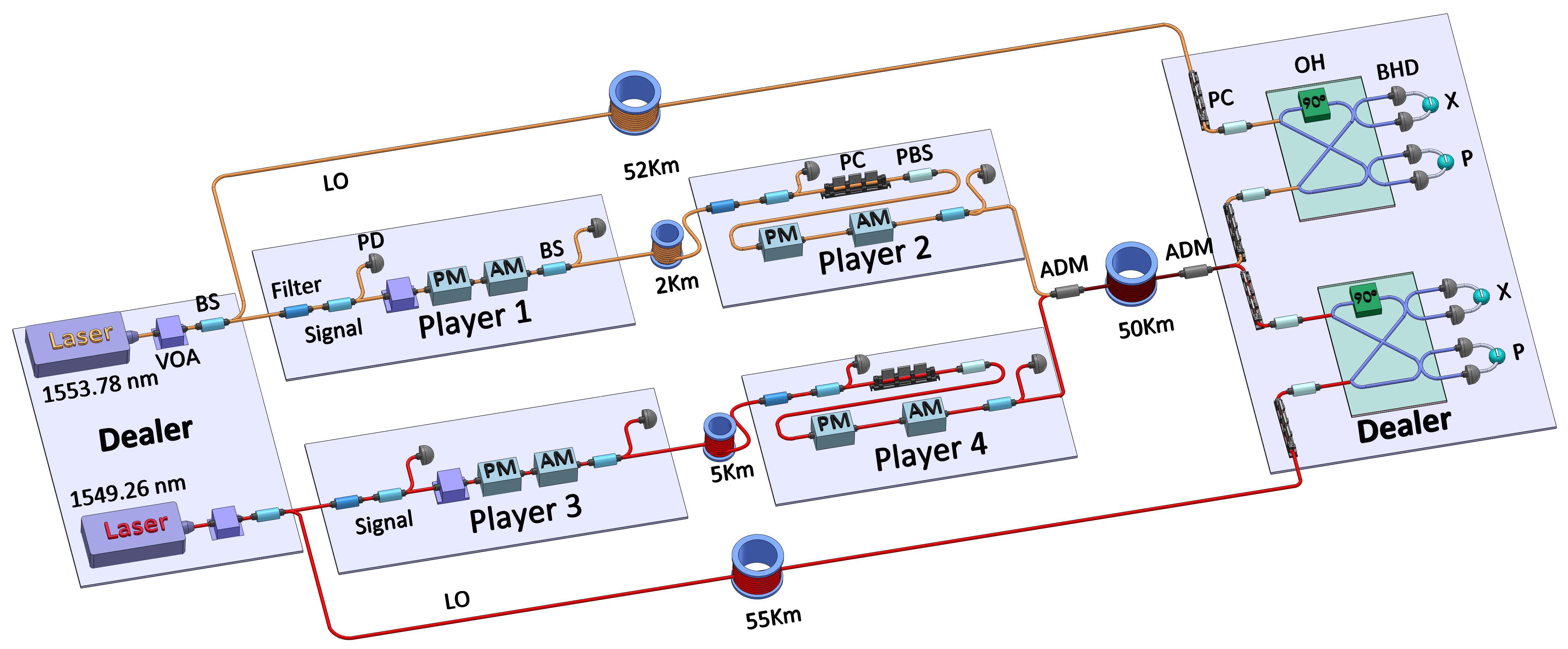
Experimental demonstration of multiparty quantum secret sharing and conference key agreement
Authors:Shuaishuai Liu, Zhenguo Lu, Pu Wang, Yan Tian, Xuyang Wang and Yongmin Li
Quantum secret sharing (QSS) and conference key agreement (CKA) provide efficient encryption approaches for realizing multi-party secure communication, which are essential components of quantum networks. In this work, a practical, scalable, verifiable (k, n) threshold continuous variable QSS protocol secure against eavesdroppers and dishonest players are proposed and demonstrated. The protocol does not require preparing the laser source by each player and phase locking of independent lasers. The parameter evaluation and key extraction can be accomplished by only the dealer and the corresponding player. By using the multiple sideband modulation, a single heterodyne detector can extract the information of multiple players. The practical security of the system is considered. The system is versatile, it can support the CKA protocol by only modifying the classic post-processing and requiring no changes to the underlying hardware architecture. By implementing the QSS and CKA protocols with five parties over 25 km (55 km) single-mode fibers, a key rate of 0.0061 (7.14 × 10-4 ) bits per pulse is observed. The results significantly reduces the system complexity and paves the way for the practical applications of QSS and CKA with efficient utilization of resources and telecom technologies.
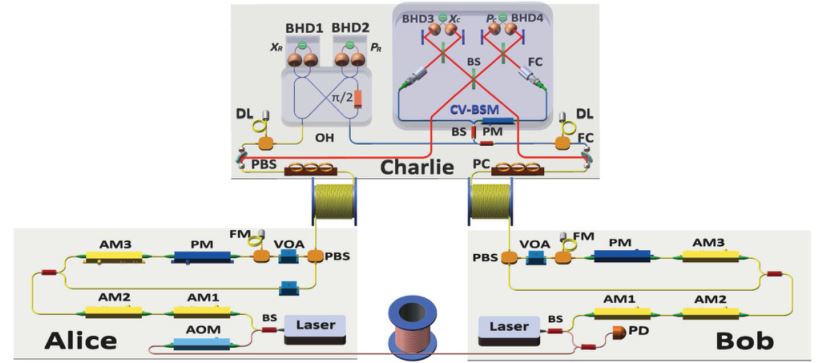
Experimental demonstration of continuous-variable measurement-device-independent quantum key distribution over optical fiber
Authors:Yan Tian, Pu Wang, Jianqiang Liu, Shanna Du, Wenyuan Liu, Zhenguo Lu, Xuyang Wang, and Yongmin Li
Measurement-device-independent quantum key distribution (MDI-QKD) can remove all side-channel attacks on detectors. In the context of the dramatic progress of discrete-variable MDI-QKD and twin-field QKD, owing to the critical challenge of continuous-variable (CV) Bell-state measurement (BSM) of two remote independent quantum states, experimental demonstration of CV-MDI-QKD over optical fiber has remained elusive. To solve this problem, a technology for CV-BSM of remote independent quantum states is developed that consists of optical phase locking, phase estimation, real-time phase feedback, and quadrature remapping in the present work. With this technology, CV-BSM is accurately implemented, and the first CV-MDI-QKD over optical fiber is demonstrated, to our knowledge. The achieved secret key rates are 0.43 (0.19) bits per pulse over a 5-km (10-km) optical fiber. Our work shows that it is feasible to build a CV-MDI-QKD system over optical fiber. Further, the results pave the way towards realization of a high secret key rate and low-cost metropolitan MDI-QKD network, and serve as a stepping stone to a CV quantum repeater.
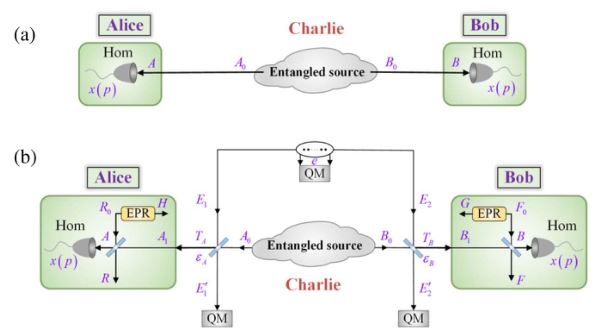
Continuous variable quantum key distribution with a shared partially characterized entangled source
Authors:Shanna Du, Pu Wang, Jianqiang Liu, Yan Tian and Yongmin Li
Locking the sophisticated and expensive entanglement sources at the shared relay node is a promising choice for building a star-type quantum network with efficient use of quantum resources, where the involved parties only need to equip low-cost and simple homodyne detectors. Here, to our best knowledge, we demonstrate the first experimental continuous variable quantum key distribution with an entanglement source between the two users. We consider a practical partially characterized entangled source and establish the security analysis model of the protocol under realistic conditions. By applying a biased base technology, the higher key rate than that of the original protocol is achieved. The experimental results demonstrate that the distance between two users can reach up to 60 km over telecom single-mode fiber, implying the feasibility for high-rate and secure communication with a shared entangled source at metropolitan distances.
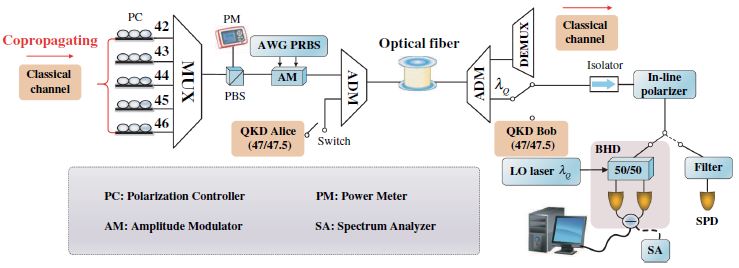
Impact of Four-Wave-Mixing Noise from Dense Wavelength-Division-Multiplexing Systems on Entangled-State Continuous-Variable QKD
Authors:Shanna Du , Yan Tian, and Yongmin Li
Integrating quantum key distribution (QKD) on the existing optical fiber network through dense wavelength-division multiplexing (DWDM) can greatly reduce the costs of quantum channels and improve the scalability and flexibility of the quantum communication network. In the scenarios of an access net-work or local area network with a large number of users, the connected optical fibers are relatively short and the quantum signal can be adjacent to the classical channels. In this case, the four-wave-mixing noise generated by the classical lights will have a severe impact on the performance of the QKD. We establish a theoretical model to characterize the excess noise in continuous-variable QKD induced by the four-wave mixing, and experimentally demonstrate the validity of the theoretical predictions. In addition, the influence of cross-phase-modulation noise between the carrier of the quantum signal and classical data channels on the QKD is investigated. To suppress the effect of the four-wave-mixing noise, an unequal channel spacing technique is employed. We realize coexistence of entangled state-based continuous-variable QKD and five adjacent DWDM classical channels with 10 dBm launch power and nonreturn-to-zero on-off-keying modulation at 2.5 Gb/s (10 Gb/s).
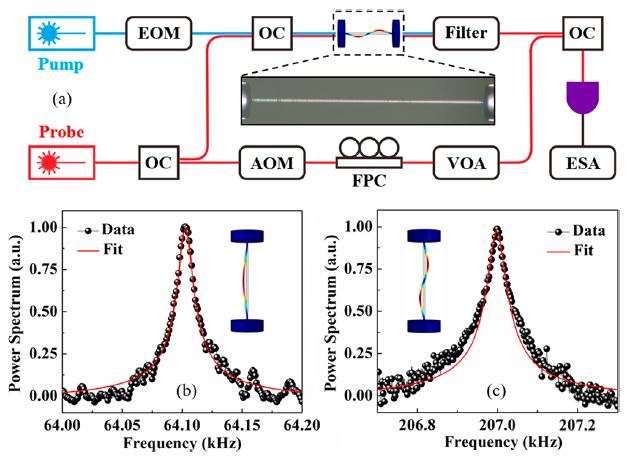
Microfiber Mechanical Resonator for Optomechanics
Authors:Qiang Zhang, Ruili Zhai, Shiwei Yang, Shuai Yang, and Yongmin Li.
Optomechanics is a promising field with important applications in ultrasensitive sensing and quantum information processing. A variety of micromechanical resonators are proposed and demonstrated for expanding the applications of optomechanical technologies. In this paper, we report a novel microfiber mechanical resonator. By designing abrupt junctions between the microfiber and single mode fibers and imposing high axial stress in the resonator, the clamping loss is decreased effectively and the resonator material's intrinsic dissipation is also diluted. Ringdown measurements at room temperature show that the quality factors Qm of the fundamental and higher-order mechanical modes of the microfiber resonators exceed 105 to yield the highest mechanical f × Qm products (>1010 Hz) yet reported for fiber-optic mechanical resonators. Moreover, employing the microfiber as a vibrating beam, the mass of the resonator is at least 1 order of magnitude less than that of the reported fiber-optic resonators with a similar f × Qm product. The proposed mechanical resonator is a promising candidate for optomechanics and provides an alternative mechanism for optical fiber sensing and communication systems.

